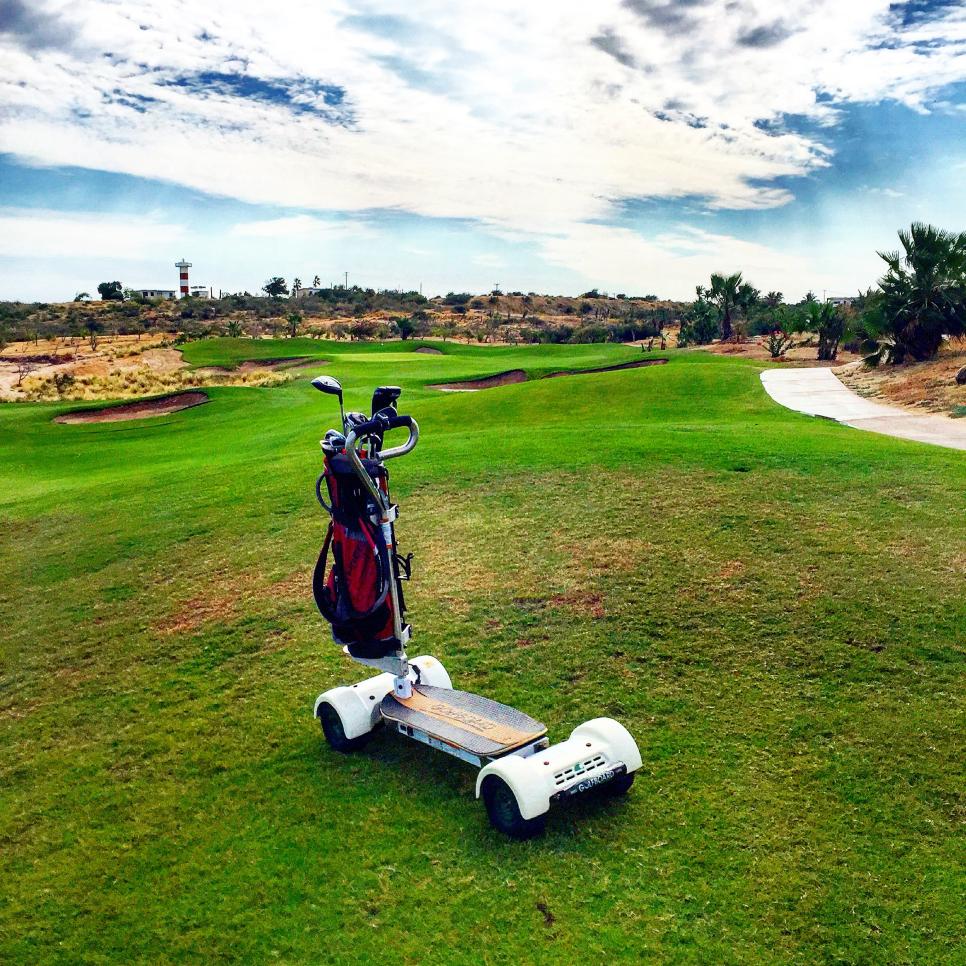The Loop
Is this the future of golf transportation?

About 13 years ago, Golf Digest sent me to Manchester (N.H.) Country Club to test a new type of golf-course transport. It was a Segway that had been repurposed to hold a golf bag. Picture a chariot from "Gladiator" except their was no horse pulling it, and the golf bag would be in the spot where the Roman centurion would have a quiver of arrows or his spears. In short, it was an awesome test drive. It made the round so much more fun and score became irrelevant. The self-balancing gyroscope technology allowed me to simply lean in whatever direction I wanted to move. The more I leaned, the faster the Segway went (up to 12 mph). I predicted back then that it would "one day be as common as a golf cart."
I'd like to take a mulligan on that. As it turns out, golf courses did not want to spend five grand apiece on the Segway HT, especially since you'd likely have to buy two for every golf cart taken out of play. And courses were already charging a lot just to play, so they felt the extra expense would not be attractive to the golfing masses. You have to keep in mind that it was a different era. Golf was as popular as ever, thanks to Tiger Woods, and no one was wondering about how to attract millennials, or anyone else for that matter, to preserve the future of the sport.
Fast forward to 2015 and golf, it seems, is in desperate need of new and exciting ways to grow. That's why I'm going to make another bold prediction and say that the Golfboard has a much better chance of success than the Segway ever had. We've already written quite a bit about Golfboard (click here for our original article back in June of 2014). And in full disclosure, Golf Digest is a "strategic partner" of the startup company Golfboard, Inc. So I realize you might already be aware of its existence and/or question my neutrality as a reviewer of the product. But this is my unbiased review:
First the particulars. I tested it in November at the Puerto Los Cabos golf course on the southern tip of the Baja Peninsula in Mexico. At the time, Puerto was not offering Golfboards for use to the general public and might scrap its plan to rent them altogether. They bought several and are trying to decide what to do with them. Regardless, director of golf Sergio Castillo let me try one for my round. My girlfriend, Allison Parker, also played with me and drove a golf cart so we could swap modes of transpo from time to time.

I tested the board with almost no knowledge of how to operate it. In all honesty, I conned the staff at Puerto into believing I had some experience on the device. Apologies, Sergio. While they were getting one out of storage, I spent five minutes watching a video on YouTube about how to operate it. It was fairly simple. Strap the golf bag on, turn on the board, make sure it was in neutral, and then jump on the way you would a skateboard or surfboard. There is a handle in front that allows you to balance, steer and operate the throttle (they can move anywhere from 5 to 14 mph). There is no brake. If you want it to stop, just take your thumb off the throttle. It also has a reverse mode in case you have to back out of a jam.
Within seconds of jumping on, I was "surfing" down to the first tee. If I wanted to steer in a certain direction, I just leaned the handle. If I wanted to make a more pronounced turn, I leaned my body into it the way you would on a motorcycle or bicycle. Puerto is an extremely hilly course, but the Golfboard did fine even on the steepest inclines. It wasn't nearly as fast as the golf cart that Allison was driving, but it was 100 times more fun. There was rarely a moment when I thought I was losing control or would crash. Another perk of Golfboarding is that you look cool. Cars were literally stopping on roads that adjoined the course to watch me roll by and other golfers on the course looked at me as enviously as if I was riding on a magic carpet.
Allison's initial experience was similar to mine, except she did NOT watch the YouTube video. She just listened to a few basic instructions from me (she hates when I bark orders) and off she went. She only tried it for a hole, but enjoyed it. Allison only plays a few times a year but said she'd play more if she could use a Golfboard.
That's the good news about the product. Now comes the bad. The first is that the Golfboard I was given ran out of battery power on the 10th hole. The second is that the replacement board they brought out to me conked out four holes later. The staff says the boards weren't fully charged, but Castillo later confessed to me that they aren't sure a fully charged board will last 18 holes on his hilly course—hence the hesitation to rent them to the public.
Another knock is how it handles curbs—not severe, squared-off curbs—but the rounded ones you find on most courses. If you roll along side of the curve of the cart path, instead of taking it head on, the Golfboard feels like it might tip over. It never did when I was riding it, but it still makes your heart jump just for a second. Now here comes the biggest knock. Remember how I mentioned that you have to lean your body from time to time in order to make a big turn? I didn't realize it then, but operating the board for a few hours might have taken its toll on my left ankle. You spend a lot of time in a bent-knee position, and your feet are in a dorsiflexed (toes up) position as you go through curves or up hills. I was fine when I left the course, but I woke up in the middle of the night after the round and could barely put weight on my left foot. Nine days later, I was still limping. I want to be clear that I'm not 100-percent sure the ankle injury was the result of prolonged Golfboarding. I also did a 15-mile bike ride and swam that day. I'm just cautioning you that if your lower body isn't ready for the rigors of the board, you could get hurt.
Neverthless, I'm still endorsing the Golfboard as a great way to experience our game. According to Golfboard officials, their success might not lie in courses purchasing the boards. Castillo says the price has increased for the commercial units to $6,500 a pop. Instead, a leasing program might allow many more courses to add them to their fleet of transports affordably in the hopes of attracting more business. The leasing program is an interesting idea. It speaks to the company's innovative spirit and, if you're lucky, will allow you to soon test one yourself.
If you're like me, you'll want to use it every time you play.